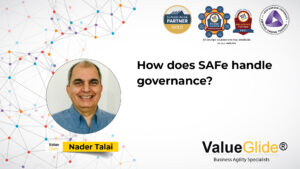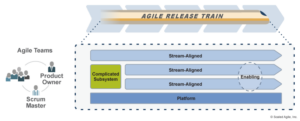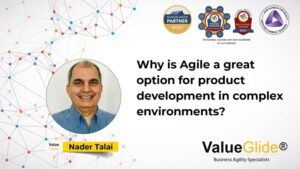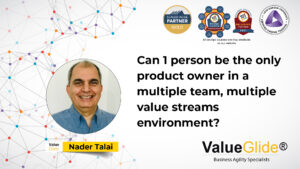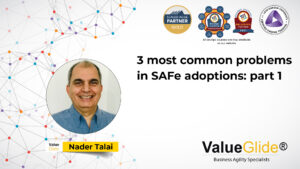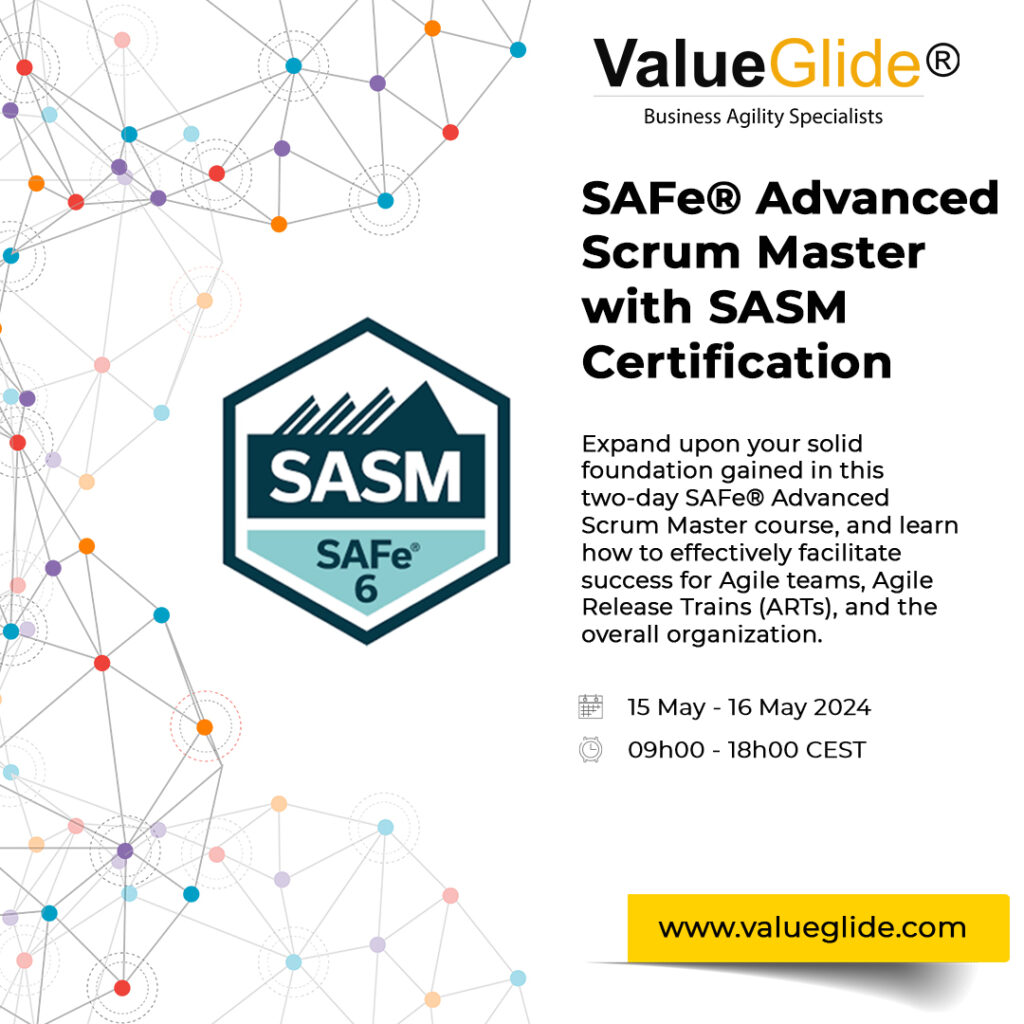Organizations in every industry across the globe are intensely focused on increasing agility,
adaptability, and innovation. The operating environment for incumbent market leaders is more turbulent than at any time in recent history. Emerging technologies, disruptive start-ups, globalization, social and political unrest, generational shifts, and even the COVID-19 pandemic have all contributed to a context for leaders that is infinitely more challenging than anything most have ever experienced. Many leaders may feel inadequately prepared for this brave new world, and yet it is leaders who have the authority and responsibility to guide their organizations successfully through challenging times.
Thriving in the digital age requires a new way of working, and a new way of leading. Harvard professors, and authors Marty Linsky and Ronald Heifetz describe the skills to guide organizations through turbulent times as “adaptive leadership.” Fortunately, for organizations adopting SAFe, many of the elements of adaptive leadership are built into the values, principles, and practices of the Scaled Agile Framework.
In this presentation, Dr. Steve Mayner, SAFe Fellow, and expert on leadership and organizational change will provide an overview of Linsky and Heifetz’s model, and how SAFe specifically enables leaders to build the competencies that will help their enterprises succeed in the digital age.
On 11 November 2021, we hosted our first virtual conference with a great lineup of speakers, here is the fifth session Adaptive leadership and the Scaled Agile Framework by Steve Mayner
About Steve Mayner
Dr. Steve Mayner is an executive coach and Lean-Agile evangelist with a passion for cultivating transformational leaders and high-performing teams. His 33+ year career in business includes roles as Vice President in multiple Fortune 500 companies, as well as Chief Technology Officer for a Health IT startup company. He also retired in 2003 as a commissioned officer in the reserve component of the U.S. Air Force with just under 21 years of service. In his current role as a SAFe® Fellow for Scaled Agile, Inc., Steve contributes to the ongoing development of the Framework and courseware with specializations in government, leadership, learning culture, and organizational change. In addition to the SAFe Summits, he has been a regular presenter at the DevOps Enterprise Summit, PMI, and various government and industry conferences.
Watch on:
The transcript for Thriving in Turbulent Times: Adaptive leadership and the Scaled Agile Framework by Steve Mayner
Nader: Thank you for joining. So it gives me great pleasure to introduce Dr. Steve Mayner, a SAFe fellow, a SAFe SPCT and with many years of experience, 33 years+ including being part of the US air force. Today is the 11th of November, which is the Armistice day. We observed a one minute silence at 11 o’clock to honor the privileges that we are benefiting from as a result of the member of the armed forces past and present. So I’m going to hand over to Steve who’s going to take us through what it is to Thrive in Turbulent Times: Adaptive Leadership using Scaled Agile Framework. Over to you, Steve.
Steve Mayner: Thanks again for the invitation. I’m delighted to be here. I understand that you’ve had quite a number of great presentations today. I hope you find this one valuable as well as we’re focusing on this challenge of thriving in turbulent times, and hopefully we can add a few extra tools in your toolkit for how to do that today.
So without further ado, let me dive right in. So without question, the last couple of years have been the most turbulent that any of us have ever experienced in our lifetimes, probably as dramatic as anything the world has ever seen, probably back all the way to World War Two, when you think about just the ubiquity and universality of the disruption and turbulence that the world has experienced due to COVID-19.
And without question the most tragic element and the most difficult element of that conversation is the lives that have been lost that overshadows any other part of this conversation by far. Many, if not, all of you have been affected personally, I know I have, I lost my mother-in-law to COVID and it’s just an incredible tragedy that has affected all of us.
When you think beyond that most important element of the last two years, there are other things that when you think of the business context and the work context that we all live in, there have been other implications. Think about the economic upheaval of companies that have shut down, many have gone out of business and won’t come back.
When you think about the impacts to families because of lost jobs, lost wages and everything that we’ve had to deal with from that perspective. There’s also political unrest as this has gone on and on, we’ve seen in many countries across the world, shifts in political power and different approaches to how to lead nations and societies through these difficult times and as those shifts happen, that creates a lot of unrest and uncertainty.
Think about what we’re experiencing even now, supply chain disruption. And again, this is something that’s affecting every industry, every company around the globe. And we’re still trying to figure out our way through this problem.
We don’t see an end to this just yet. And part of it is really inflamed by what many in the media and press and social media are calling the great resignation. So many people put out of work and as the ability to go back into the workforce is becoming present, many are deciding to use this as a time to reflect and re-evaluate and perhaps take their career in a different direction.
And thus it’s creating labor shortages and real difficulties for so many organizations, all of these just predicated by what we’ve experienced over the last couple of years.
But turbulence, isn’t always and exclusively limited to things that are tragic like COVID, they can also be predicated by things that are exciting and inspiring.
We think about shifts in technology and capabilities that are emerging that we have available to us that we wouldn’t have imagined just a few years ago, things like artificial intelligence, machine learning becoming just such a game changer in so many industries and we’re going to be writing more about that in the framework.
Think about blockchain has the potential to completely recreate and re-imagine what we know as currency today. 3D printing. We have Elon Musk here in the United States that’s able to launch rockets at an unbelievable pace and largely due because he can 3D print so much of every rocket. Who would have imagined that and just go on down the list and so many of these things are exciting. They definitely can create turbulence and disruption in a market in a positive way, if you’re the company that is leveraging these capabilities to build competitive advantage and certainly concerning if it’s your competition who’s using these technologies to serve customers better and perhaps pull customers away from you.
So both exciting and challenging times created just by the emergence of new technologies.
So these factors and many others are creating undoubtedly not just a VUCA market or geography, but literally the entire world is in this mode. And I think you’ve had some other speakers today on the agenda talking about VUCA, but just so you know what we’re talking about, we’re talking about volatility, uncertainty, complexity, and ambiguity. That describes the world we are in today, without question.
And here’s the thing that I hope you gained from the other speakers today and if not, I’m certainly going to put my 2 cents in on this, I think this is the world we’re gonna live in from now on. I think those that are hoping that once COVID finally fades into the background, we can all go back to some kind of quote, unquote normal.
But I truly believe that the normal that we knew before is never coming back, that what we have to accept and be prepared to deal with is a new normal where volatility, uncertainty, complexity, and ambiguity are in fact, the norm and what competencies do we have to deal with that is going to be a critical question.
Jeff Bezos talked about this, the founder of Amazon in this era of volatility, there’s no other way to survive, but to constantly reinvent. And the only sustainable advantage you have over the others is agility, right? If you want to be successful in turbulent times, that means you have to constantly adapt and to adapt, you have to have agility as a competency, and obviously, at Scaled Agile we’re excited about the opportunity that has to do or that has for us to be able to help the world embrace agility and be very competent in agility.
And we’ll talk more about that as I go through this talk, but here’s where I think we are.
I really believe this. Having talked to so many of our customers and the global 2000, I think we’re at an inflection point in many of these organizations. And that is as COVID is starting to get more in our rear view mirror, as we’re dealing with the economic fallout of what we’ve been through the last couple of years as the workforce changes start to settle, I believe that organizational leaders are faced with this fundamental crossroads decision. Now that the crisis has passed, do we go back to the old habits? Do we try to return to the way things were before COVID hit? Look, let’s be honest. When COVID hit, we got to see adaptability and agility on a scale we’ve never seen before.
Whether you believed you needed to engage in digital transformation, that wasn’t a question anymore. Everyone, every industry, large and small across the world was forced to adapt and change if they wanted to survive. No argument. But now that the crisis is starting to pass, leaders may feel they have the luxury to decide: we try to go back to the way things were before, or do we embrace what we learned about this ability to rapidly respond and adapt and change and evolve and make this our new normal ? Embrace these as new competencies. And so for every organization, for the organizations that are represented here by the people that are attending this session, obviously I’m going to advocate for the choice to embrace the change and make this a permanent change because of what we just described, what Jeff Bezos talked about and what I believe is going to be the real future, which is: the conditions are not going to be favorable to allow us to go back to the old habits. And if we do, we’re really putting our organizations at risk and certainly we don’t want to see that happen.
So here’s what this all boils down to. What we need is for organizational leaders to understand that these turbulent times, the need to be adaptive, the need to have agility is going to continue for as far as we can see into the future. And what that means, from a leadership perspective is that leaders need some new skills.
The ability to lead through these difficult turbulent volatile times requires some capabilities and some competencies and some skills that many leaders may not have really invested in until COVID hit. And they were forced to learn quickly and to learn some new skills.
Let’s now focus on what those skills are, what those behaviors and competencies are and make sure that we can sustain them into the future and provide that leadership to our organizations.
So what does that mean? So I’m going to talk about a particular set of thought leadership in the world called adaptive leadership. And we’ll explore that just for a few minutes, but let me say something at this point upfront, think of this as a another set of tools in your toolkit as a leader, I’m certainly not advocating that at scaled agile, we’re going to move away from Lean-Agile leadership or from transformational leadership or servant leadership. These are all tools in the toolkit. So just think of it from that perspective and if you’re a leader, evaluate where do you stand as we describe this set of leadership skills, if you work with leaders, think about those leaders and where they stand and how you might help them down this path.
So first let’s understand what Adaptive Leadership is. Many of you may be familiar with this, with the writings around this, but let’s just set a common definition. So Adaptive Leadership is “successful behaviors for dealing with consequential changes in uncertain times” and here’s the distinction “when no clear answers are forthcoming”.
And that’s certainly what we faced when COVID hit. We knew it was going to be significant, consequential. There was lots of uncertainty and we didn’t know how we were going to get through it. We didn’t know how we’re going to have to transform our organizations. And so absolutely an adaptive situation.
I’ve got a citation down there in the bottom, Dr. Ron Heifetz and his associates have been leading this development of the writings on Adaptive Leadership for some time, you can read more about what they describe in greater detail in the resource there.
So let’s unpack it a little bit more. Adaptive Leadership, first of all, has four different characteristics or attributes that Dr. Heifetz talks about. And let’s just unpack that for a moment. And let’s think about this in terms of how we feel in our organizations as we went through the last couple of years.
So the first attribute they talked about is the character of an adaptive leader. And what we mean by that is, are they honest? Are they transparent? When they make a mistake, do they admit it? Do they own it? Or do they try to pass it off to someone else? Are they creative? Are they credible? Do they lean more on earned respect and authority than their formal authority?
Do they value the differences that different people bring to the organization? So these are just some of the attributes that you think about what it means that an adaptive leader is a person of character.
The second attribute is an adaptive leader is emotionally intelligent. I think we all understand that body of knowledge, right?
They’re self-aware of their own emotions. They’re able to self-regulate their own emotions. They have a social awareness, but they’re also aware of other’s emotions. They have respect for people’s feelings. They build positive relationships, they build trust. And again, think about an adaptive situation. Change is required, change causes people to react emotionally. And so an adaptive leader understands that he doesn’t just deal with the intellectual side, but they also deal with the emotional side of our humanity to create that environment of trust where people will be able to move through these very difficult situations.
Organizational justice is the third characteristic and what Dr. Heifetz and the other authors mean by this is, it’s an interesting term, but basically it’s this sense of fairness. I’ll just give you a short anecdote, in our own company as COVID hit and our business stopped on a dime because historically we were all about in-person classes. Now COVID hit, you couldn’t have any in-person classes at all, not just us, but all of our partners. So the very survival of our company hung in the balance. And there was a time period where financially it was very difficult, but our leaders made the decision that we were going to have to do some slight reductions in salaries, but everyone participated equally and fairly.
So that everybody had a little bit of pain instead of a few people having a lot of pain. And that gave us such respect for our leaders because it was fair. So this idea of fairness, of sharing information openly, focusing more on outcomes than outputs or processes valuing and respecting everybody welcoming multiple viewpoints and most importantly, inviting participation in change as Dr. Kotter, a great thought leader in change leadership describes, really getting the volunteer army, getting everyone involved in the change, not just having a few decide on a change and then try to push it down on everybody else.
And then the fourth element is this focus on development, a leader individually themselves being a lifelong learner, but also helping others develop as well.
Having this environment of discovery and experimentation, which is the rich fertile soil for learning, understanding that mistakes will be made anytime you make or engage in an experiment, it’s not always going to go the way you think. And so, rather than punishing something that doesn’t work, use it as an opportunity to learn and grow and do better the next time.
And then when something doesn’t work, when a solution’s not the right one, pivot without mercy or guilt, right? Just say, look, we just learned a way not to do this. So let’s take that learning and let’s find a better way and keep pressing forward. So these are the four elements that Dr. Heifetz talks about. And I love this quote from the book that really encapsulates it: “leadership is a difficult practice personally, because it almost always requires you to make a challenging adaptation yourself”. And you can read the rest of the quote here but what I love about this is, to understand that as leaders, if we want to be adaptive leaders, if we understand we need to lead our organizations through a period of adapting to this volatility and uncertainty and ambiguity.
Instead of focusing on the organization first, we need to focus on ourselves first. Are we in fact adaptive as individual leaders? How are we changing? How are we growing? How are we shifting to meet the new demands that the leadership context requires? And we need to examine that before we ask the organization and we ask others to change.
So that’s a quick definitional review of what adaptive leadership is, but he also talks about this idea of an adaptive challenge. So what is it about the situation that requires this adaptive leadership? An adaptive challenge refers to situations where there are no known solutions to the problem or cases where there are too many solutions, but no clear choices and you see the rest of the description there. And it’s really about taking as the last bullet says, not just the short-term fix, but really looking to the root causes of what’s created this situation and the deeper truth that will help us determine long-term solutions.
And he provides a great compare and contrast of adaptive challenges to technical challenges. So as we start to shift in the next few slides about how adopting the scaled agile framework already has great guidance in it to help you deal with this uncertainty, with the need to be adaptive and to have agility as Jeff Bezos talks about, understanding that we need to look at the challenges that we’re facing and decide: is this a truly an adaptive challenge where this adaptive leadership set of skills is going to be absolutely critical? Or is this a technical challenge? The more of our traditional kinds of challenges, problems we have to solve. And there’s a significant compare and contrast here. You may think back to what changes you had to implement in your organization when COVID hit and look at it in light of these characteristics that you see on the right-hand side of the screen. And invariably, that circumstance was unquestionably an adaptive challenge for all of us.
Now let’s even think about it in terms of adopting SAFe, adopting Lean Agile as a new way of working in the organization. Is the need for this change to a new way of working difficult to identify, easy to deny?
If you’re a change agent and transformation leader, you understand that’s very true. Does adopting SAFe require changes in values and beliefs and roles and relationships and approaches to work? Absolutely. Does it require that the people with the problem do the work of solving the problem? Absolutely. Think about decentralized decision-making and all the enablement we provide to agile teams. Or does it require changes in numerous places, cross organizational boundaries? Absolutely. Do people often resist even acknowledging the challenges that exist if you’ve spent any time working with transformations you know that’s certainly true. And solutions require experiments, discoveries can take a long time to implement and don’t work if it’s done by edict. Those are all true. So what we know is yes, adopting SAFe is in of itself an adaptive challenge, but the good news here is that SAFe also provides the tools for how we overcome this challenge, how we embrace agility as Jeff Bezos describes and become an adaptive organization able to thrive in turbulent times.
So let’s talk about exactly how does SAFe do that? Now I’m not going to talk about what most people traditionally think about SAFe when you think about agile teams and backlogs and team practices and PI planning and the PI cadence, and the kind of the normal starting points for thinking about adopting agile.
Now, those things are all important. They’re all true. They’re all very much part of the equation. And I’m going to focus the remaining time on how SAFe enables adaptability, really more on those elements that would more directly involve leaders, because I think leaders truly are the critical element of whether an organization is going to be an adaptive organization or not.
And I’m going to focus on areas of the framework that maybe don’t get as much focus, don’t get as much attention, as much headline when we think about the framework. So as I’ve already stated, I believe it all starts with leadership and you will find, if you read the articles around leadership in SAFe, you will find that virtually every behavior in trait of adaptive leaders that we just reviewed from Dr. Heifetz is reflected in these articles that I’ve highlighted on the screen. So if you go to the Lean Agile Leadership article, if you go to the Continuous Learning Culture Competency article, if you look at the Core Values and Mindsets and Principles articles at the bottom, you’re going to see all of these traits and attributes that we’ve already written about and encourage leaders to embrace in the framework.
Think about mindsets and principles. Talk about leading by example and some of the very things we just talked about, emotional intelligence, lifelong learning, growing others, authenticity, right? That character aspect, the ability to lead change. Though, all of those characteristics are right there in the Lean Agile Leadership Competency article, in the learning culture article: Peter Senge’s Systems Thinking, right? The learning organization, relentless improvement, being innovative, adapting means you’re changing to something. What’s the something you’re changing to and is it truly innovative in bringing something new to the table that’s going to help you survive and be successful in this very different and difficult context?
Think about the values and principles that SAFe is built on. The house of Lean. Every element there: the agile manifesto, one of the four big values of agile, the very last one responding to change. It’s right there. SAFe core values, alignment, transparency, the principles, principle number three: assume variability, preserve options.
Number four, build incrementally with fast integrated learning cycles. So when you really look at it through the lens of the guidance we provided to leaders, primarily in some of these articles in SAFe, the elements of adaptability have been fundamental and foundational in the framework for a very long time.
Now to help leaders really reconnect and practice this. We’ve got a brand new product coming out. You’ll learn more about it here, in the coming days, called “Leading In The Digital Age”. It’s our role-based training for leaders and something that the market’s asked of us for a long time. It’ll start with two modules leading by example and accelerating change leadership, those elements of the competency article that you just saw, but we’ve got ideas for future modules of the series that we might offer, including one that we’ve sketched out called “Thriving in Disruption”. So stay tuned for more information on that.
Let’s talk about another area of the framework where adaptability is really enabled for organizations that have adopted SAFe, and it’s in the lean portfolio management. That top layer and that top layer is really aimed at leaders, the decision makers, the people who are in a position to align strategy with execution, to define the strategy, to prioritize where our solution development efforts are aimed, to budget for those things, to provide governance for those things. And so the elements, the tools we put in that level are really designed to help leaders understand how do we respond and respond rapidly so that we deliver value to market in days or weeks, not months or years.
Very recently we’ve gone deeper in our guidance on this and written an article called “Business Agility Value Stream”. It may be agency agility if you’re with a government organization. So if you can think about it that way, the URL to there, it’s an advanced topic article, so if you know where to find advanced topic articles in SaFe, just look right there in the B’s and you’ll see the business agility value stream.
And we’ve got a lot of guidance in there to really lift up the conversation to an organizational level to say, look, the whole point of SaFe, the whole point of adopting a new way of working is to really shorten the time span between when a business opportunity or need emerges and when that need or opportunity is met or leveraged, right?
That’s the whole point. Fast value, fast time to market, fast ability to pivot and respond to change when it’s required. We talk about the different steps in here, but it’s really all about thinking about how quickly we can get new capabilities to market, literally in a matter of days and weeks, not in months or years, that’s the fundamental shift. That’s what you need to be able to do if you’re going to be adaptive as an organization in thriving in disruptive or turbulent times.
So not going to go deep into what Lean Portfolio Management is, but think of this truly as the key that’s gonna unlock agility and adaptability for an organization, because you’re going to bring the leaders who have these decision making authorities today around strategy, around budgets, around the prioritization of initiatives around governance, but you’re going to retrain them.
You’re going to retool them and you’re going to give them a new way of working, a new way of executing their responsibilities. So that aligns with the core values and principles and mindsets of lean and agile that we’ve taught to the rest of the organization.
We’ve invested a lot recently, and we’re still investing in the training around Lean Portfolio Management. We’re doing some tests literally as we speak, with a new getting started workshop that we’re reconstructing, we’re getting amazing positive comments on it. So if you really want to know more about it, there’s no better way to get that learning then to explore the course that we have built around Lean Portfolio Management.
The third and ,final area of the framework that I think doesn’t get a lot of attention, but is really a critical concern for leaders who are trying to build an adaptive organization, is embracing agile product management.
So this is a discipline. This is a serious rethinking about how we manage our products in the marketplace with using customer centricity, design thinking, the continuous delivery pipeline. It’s all about delivering the right solutions to market quickly with speed, with quality and so it really depends on these elements that we write about in the competency article.
We provide tons of tools whether it’s design thinking, personas, empathy maps, customer journey maps, the business model canvas. These are all tools that I know in my past, in the Waterfall world of project management, we weren’t doing any of these things.
But this is a new discipline. This is a discipline that organizations that want to be adaptive have to embrace because the whole idea of adaptability is we have to change, we have to change the products that we’re bringing to market, how we’re bringing them to market, what markets we’re bringing them to.
How do you know what those changes need to be? How do you know what the right best product is? It’s really got to meet the needs of customers and meet them quickly. That requires a new set of practices and disciplines for many organizations that aren’t doing this, and you gotta learn it, you’ve gotta learn these skills.
So again we’ve got a course that we’ve had for a while on agile product management. It too is going through a major retooling, just like we’ve done with Lean Portfolio Management, so stay tuned for that. But this is where you’re going to gain those skills to understand from leading the product side of this and having that adaptability, how are you going to make sure that what we adapt to, is fit for design, fit for purpose, fit for use and is really going to be successful in meeting the need of the market or the customer we’re trying to serve?
One last thought, all of these disciplines are critical. They’re important, but we can’t lose sight of the fact that how will we know if we’ve adapted correctly? How will we know if we’ve responded in a way that’s going to lead to success? We got to measure, we’ve got to have data, we’ve got to change and then evaluate, that plan do check adjust cycle is critical. You have to know, you have to measure, you have to have the data. So we’ve updated the measure and grow article and our metrics articles to really focus the organization around three sets of metrics around the competencies. Do we have these skills? Are we demonstrating these skills of agility and adaptability effective as an organization? Do we have flow? Is the value flowing quickly to market in the time that the market needs because of these practices and what are the outcomes? Are we actually getting the hard business results that we expect to get when we adapt, when we shift to this new way of working and thinking about how we respond quickly in turbulent times with the products and services that we’re taking to market?
And I’ll just close with this. Dr. Kotter is obviously, foremost expert in this concept of change, has been for decades. His writings are deeply ingrained into the framework and I’ve had the honor and privilege of actually getting to meet and know Dr. Kotter personally. He just wrote a new book recently called “Change: How Organizations Achieve Hard-to-Imagine Results in Uncertain and Volatile Times” . How timely is that for all of us? And just his quote: “The world is changing at a rate at which the basic systems, structures, and cultures built over the past century cannot keep up with the demands being placed on them”.
That means we need a new way of working. We need to work differently if we’re going to build the future in our markets that we serve and I hope what we’ve just discussed and covered will give you some thoughts on how you and your organization can do that. Thank you for the time. I believe we may have some time for some questions and I’d be delighted to answer those if we have any.
Nader: Thank you, Steve. Just give a minute or two for people to ask questions. You can put it in the chat, use the QA panel, just put it in the chat, it’s the easiest thing.
While we’re waiting for the questions to come through. So you mentioned about the new leadership program that you’re planning and will be available shortly. Do you have an idea of the timescale, the timeline, when will that be available?
Steve Mayner: Absolutely. We are well on a track, on a pace to have it accessible for our enterprise customers and our partners who are validated to deliver it by the end of the year, hopefully within the next. Now we’re kind of in a race against the Thanksgiving holidays here in the United States so it may fall on the other side of that, but certainly before we hit the Christmas holidays, we plan to have it accessible. And then after the first of the year, you’re going to start seeing the typical marketing communication that we typically would give with any of our products that we release to market. So you’ll hear more about it after the first of the year, but we want to at least make it accessible to our enterprise customers before the end of the year so they can start getting familiar with it.
Nader: Thank you for that. Steve. Let’s just see whether we’ve got any question.
The question is while we know the concepts of what, and to an extent, how, on the field, when the agile coach struggles alone to make decisions, can we have a 24/ 7 agile live support in the world? Is that feasible?
Steve Mayner: That’s a great idea. And I appreciate that thought, but I know of no, 1-800 dial a coach support line that’s necessarily available just like that, but that doesn’t mean you can’t have a very similar type of effect.
Let me just talk about a couple of things that I know I’ve certainly done in my career and that’s helped me and I would encourage everyone to do likewise. So right off the bat, and I’m going to assume, first of all, that we’re talking about in a SAFe context. So I can’t really speak to other frameworks and methodologies, but I know at Scaled Agile we are very much trying to enable that kind of community conversation and help.
So I would suggest to this individual, if you’re an SPC, if you’re part of the SAFe coaching community, take advantage of the forums that we have on the platform, I’m in there every so often and the conversations going back and forth are very active. There are deep experts in the field and from our partners, our SPCTs , our fellows who are in those forums and they’re answering questions on a pretty timely basis that are posed in those channels, particularly in the SPC channel.
So take advantage of that. That’s connecting you. That’s almost like that 1-800 kind of service. The second thing that I would definitely encourage is, if you’re in a company, let’s say you’re in a company that does agile coaching, and you’ve got a number of coaches there.
If you haven’t formed a community of practice or some way to really share the learnings and insights and experiences with each other and have that support network, at all times then absolutely do that. And even within your customer, or if you’re on the enterprise side, building a healthy community of practice, if you’ve got a healthy LACE, that should be one of the LACE’s responsibilities, building those communities of practice, including among the coaches.
We are much better together and I think that’s the sentiment that’s being expressed here. So there are tools and there are mechanisms to get that capability going that you don’t have to depend on somebody else. You don’t have to wait for this. Take action yourself. I really feel for anybody that’s an agile coach that’s out there on their own, solo practitioner, not part of a company, doesn’t have that network. That’s gotta be tough. Find those ready-made networks that are there and start at least by leveraging.
Nader: Yeah, I can say, as somebody who’s benefited from those forums, the Scaled Agile forums definitely worth joining. I’ve asked questions. I’ve answered questions.
Steve Mayner: You might even find me hanging out there.
Nader: Excellent. I’ve also shared the link for the feedback session. Please take a moment. It shouldn’t take you more than few minutes to fill that feedback.
Feedback is important for us and it’s important for the speakers, for Steve and others. We will share that with them to see what we can improve, because we all need to improve and without feedback, we have no idea. So please provide it. .
Thank you very much, Steve. I know it’s early morning for you. Thanks very much.
Steve Mayner: Thanks again for the invitation.


